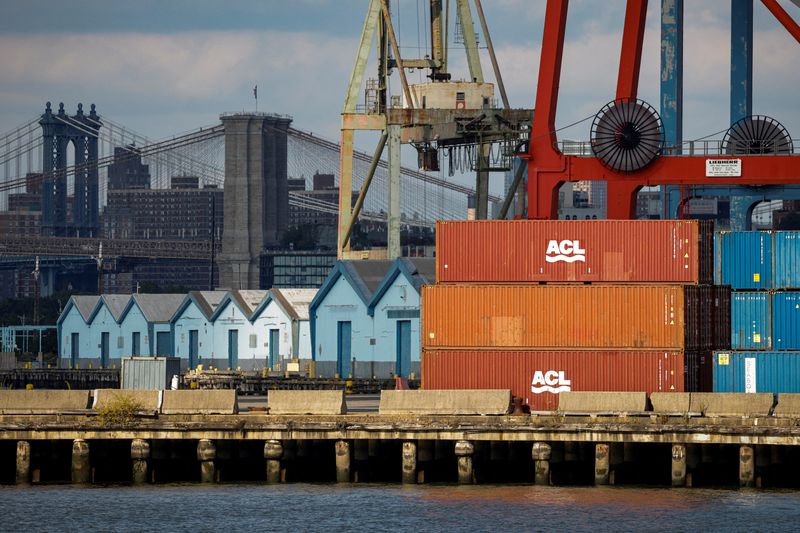By Lisa Baertlein, Timothy Aeppel
LOS ANGELES/NEW YORK (Reuters) -U.S. companies that rely on East and Gulf Coast seaports have been importing early, shifting goods to the West Coast, and even putting cargo on pricey flights to hedge against a threatened Oct. 1 strike that could jam supply chains and reignite inflation ahead of the U.S. presidential election.
"This is just another headache after everything else we've been dealing with," said Kenneth Sanchez, CEO of Chesapeake Specialty Products, which sends goods like metallic abrasives and foundry sand additives used to make engine blocks and transmissions to customers around the world.
His main port is in Baltimore, one of three dozen covered by an expiring contract between the International Longshoremen's Association (ILA) union representing 45,000 port workers and the United States Maritime Alliance employer group, whose renewal talks are at an impasse over pay.
The threatened walkout would come just five weeks before a presidential election between Democratic Vice President Kamala Harris and Republican former President Donald Trump that is likely to turn on pocketbook issues.
A prolonged strike, alongside an ongoing strike by 30,000 machinists at Boeing (NYSE:BA) that has already started to ripple through the aircraft maker's supplier network, could put a dent in the U.S. job market next month at a critical moment. Economists at Oxford Economics last week estimated the two labor actions could reduce payrolls growth by 100,000 jobs if they stretch into mid-October.
For Sanchez, it would be the second big supply chain setback after a bridge collapse cut off most access to the Baltimore port from late March through mid-June.
"Things were just starting to get back to normal," he said.
Now, he is working on a plan to put shipments on trains to West Coast ports - should the ILA's members go on a prolonged strike at ports that stretch from Maine to Texas and handle about half of U.S. ocean trade.
German chain saw manufacturer STIHL said it is also developing contingency plans to keep exports flowing from its factory near the Port of Virginia, but didn't elaborate. STIHL's U.S. plant ships products to over 80 countries.
Retailers, manufacturers and other importers, meanwhile, have been rushing in apparel, home goods, machine parts and other items ahead of the strike deadline to avoid having cargo stuck.
That sent U.S. imports to multi-year highs in July and August - exacerbating a shipping price increase tied to rerouting vessels around Africa to avoid rebel attacks on ships near the key Suez Canal trade shortcut.
Ronnie Robinson, chief supply chain officer at DSW parent company Designer Brands (NYSE:DBI), normally routes about 20% of the company's shoe imports through the East Coast. He shifted about half of those goods to the West Coast. And, he paid ten times more than a typical ocean transit to fly in a small shipment of leather boots and dress shoes from Brazil.
"People are paying whatever they can to make sure they're in the front of the queue," said Robinson, who added his company cannot risk late deliveries to clients like Macy's (NYSE:M), Nordstrom (NYSE:JWN) and Dillard's (NYSE:DDS) department stores.
Still, Robinson has 10,000 to 20,000 units in transit via East Coast-bound ships "that we're worried about".
STRANDED CARGO, SOARING RATES
As of Saturday, there were 42 container ships scheduled to arrive at the Port of New York and New Jersey, one of the biggest ports involved in the labor dispute, according to S&P Global's maritime tracking service Sea-web. Thirteen of the ships are scheduled to arrive after Sept. 30.
In August, the five largest ports on the East and Gulf Coasts processed about 24,766 40-foot containers of imports and exports valued at $2.7 billion each day, according to John McCown, senior fellow at the Center for Maritime Strategy.
Incoming wine and auto parts from Europe are vulnerable. Rerouting those goods to the West Coast is challenging because it could require difficult-to find transit through the Panama Canal, air freight or other time-consuming or costly measures, logistics experts said.
Ports on the East and Gulf Coasts also handle roughly 75% of the bananas that enter the United States, according to Jason Miller, interim chair of Michigan State University's department of supply chain management. He added that it doesn't make financial sense to reroute or fly in such low-value perishables.

The cost to send a 40-foot container from Shanghai to New York jumped to around $10,000 in July. Rates have since retreated, but could spike again with a strike.
"If the cost of shipping goes up ... it gets pushed onto the end consumer - whether that's someone buying a car or someone buying a metal part in a hardware store," Chesapeake's Sanchez said.